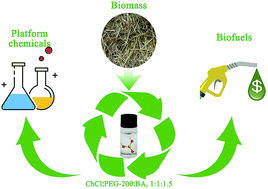New ternary deep eutectic solvents for effective wheat straw deconstruction into its high-value utilization under near-neutral conditions†
Abstract
In order to extract lignin, a novel near-neutral deep eutectic solvent (DES) was developed to treat wheat straw which facilitated its subsequent enzymatic glycation. The DES, whose in situ complexation promotes lignin depolymerization, was composed of choline chloride (ChCl), boric acid (BA), and polyethylene glycol-200 (PEG-200). Our results showed that this kind of DES could dissolve a large amount of lignin and hemicellulose yet retained cellulose well. Under optimum conditions (DES ratio of 1 : 1 : 1.5, 120 °C, 4 h), the proportions of lignin and hemicellulose removed amounted to 88.39% and 84.38%, respectively, with enzymatic digestibility reaching 59.3% in the subsequent enzymatic saccharification with a limited timeframe (5 days) and low enzyme load (30 FPU g−1). The results also demonstrated that lignin's removal rate was positively correlated with the amount of BA used in the DES. The 2D-HSQC NMR, FTIR and TG analyses showed the regenerated lignin to be a typical H–G–S type retaining its intact structure (e.g., β-O-4, β-β, β-5, etc.), whose carbon chain backbone is stable. GPC analysis revealed that this extracted lignin had low molecular weight and a narrower distribution range. Density functional theory showed that BA could bond with –OH similar to Cl−, and it occupied more effective sites than Cl− to break the hydrogen-bonding network between lignin and cellulose. Importantly, the DES can be used multiple times without significantly reducing its efficiency, and its structure and properties remain virtually unchanged throughout the use cycle.



 Please wait while we load your content...
Please wait while we load your content...